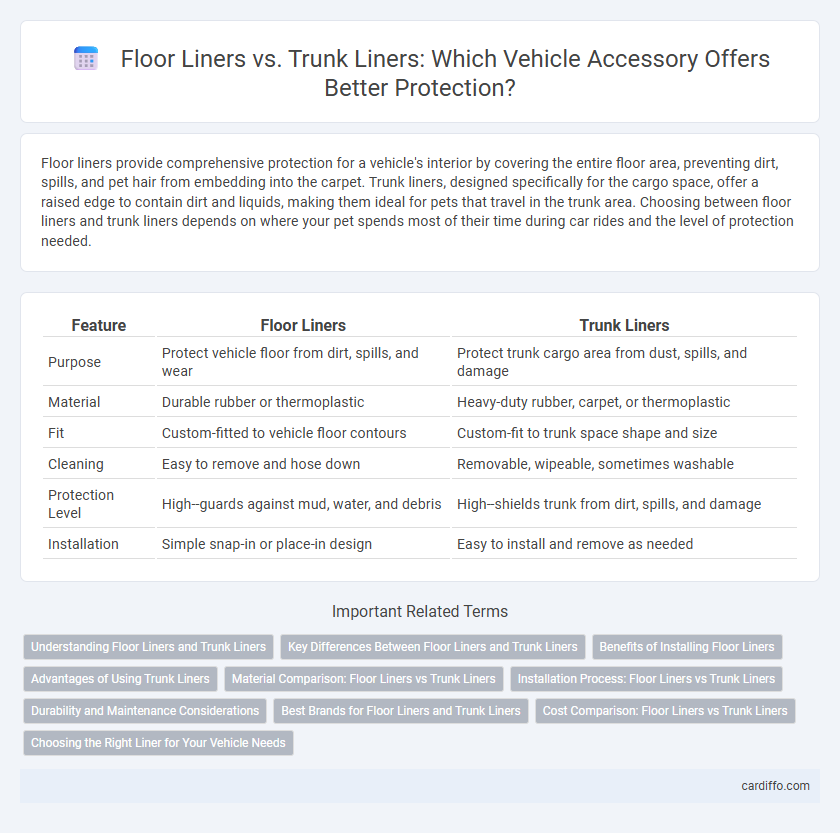Floor liners provide comprehensive protection for a vehicle's interior by covering the entire floor area, preventing dirt, spills, and pet hair from embedding into the carpet. Trunk liners, designed specifically for the cargo space, offer a raised edge to contain dirt and liquids, making them ideal for pets that travel in the trunk area. Choosing between floor liners and trunk liners depends on where your pet spends most of their time during car rides and the level of protection needed.
Table of Comparison
| Feature | Floor Liners | Trunk Liners |
|---|---|---|
| Purpose | Protect vehicle floor from dirt, spills, and wear | Protect trunk cargo area from dust, spills, and damage |
| Material | Durable rubber or thermoplastic | Heavy-duty rubber, carpet, or thermoplastic |
| Fit | Custom-fitted to vehicle floor contours | Custom-fit to trunk space shape and size |
| Cleaning | Easy to remove and hose down | Removable, wipeable, sometimes washable |
| Protection Level | High--guards against mud, water, and debris | High--shields trunk from dirt, spills, and damage |
| Installation | Simple snap-in or place-in design | Easy to install and remove as needed |
Understanding Floor Liners and Trunk Liners
Floor liners are custom-fit mats designed to protect a vehicle's footwells from dirt, moisture, and wear, often made from durable rubber or thermoplastic materials. Trunk liners serve a similar protective purpose but are specifically designed to safeguard the cargo area, preventing damage from spills, dirt, and heavy objects. Both accessories enhance vehicle cleanliness and longevity by providing tailored coverage and easy maintenance options.
Key Differences Between Floor Liners and Trunk Liners
Floor liners are designed to protect the vehicle's interior flooring from dirt, mud, and spills, fitting precisely around the footwells and pedals. Trunk liners specifically shield the cargo area from heavy wear, moisture, and debris, often featuring raised edges to contain spills. The primary distinction lies in their targeted coverage areas, with floor liners focused on passenger compartments and trunk liners on the rear storage space.
Benefits of Installing Floor Liners
Floor liners provide superior protection for vehicle interiors by shielding carpet from dirt, mud, and spills, which helps maintain resale value. Made from durable, heavy-duty materials like thermoplastic or rubber, they are custom-fit to prevent water and debris from spreading. Easy to clean and designed to withstand harsh conditions, floor liners enhance both functionality and aesthetics inside the vehicle.
Advantages of Using Trunk Liners
Trunk liners provide superior protection against spills, dirt, and wear, preserving the vehicle's cargo area from damage and stains. They are custom-fit to the trunk's dimensions, ensuring maximum coverage and easy cleaning compared to floor liners that primarily protect footwells. Trunk liners enhance vehicle resale value by maintaining a clean and well-preserved trunk space over time.
Material Comparison: Floor Liners vs Trunk Liners
Floor liners are typically made from heavy-duty rubber or thermoplastic materials designed to withstand dirt, moisture, and wear in high-traffic areas of the vehicle's interior. Trunk liners often utilize similar materials but may include additional features such as raised edges or carpet-like textures to protect cargo and provide cushioning. Both floor and trunk liners prioritize durability and easy cleaning, but floor liners emphasize slip resistance while trunk liners focus on maximizing cargo protection.
Installation Process: Floor Liners vs Trunk Liners
Floor liners typically require precise alignment to fit the contours of the vehicle's footwells and secure attachments such as clips or anchors for stability. Trunk liners often involve a simpler installation, usually requiring only placement and adjustment to fit the cargo area without additional fasteners. Both accessories are designed for ease of removal and cleaning, but floor liners demand more precise fitting due to foot traffic and potential shifting during vehicle operation.
Durability and Maintenance Considerations
Floor liners offer superior durability due to their thick, molded construction that resists wear and tear from constant foot traffic and debris exposure. Trunk liners, designed for cargo areas, are typically made from flexible, waterproof materials that protect against spills and dirt, but may be less resistant to heavy abrasion. Maintenance for floor liners involves regular cleaning to remove dirt and moisture that can degrade material over time, whereas trunk liners require frequent wiping to prevent odor and stains from spilled items.
Best Brands for Floor Liners and Trunk Liners
WeatherTech and Husky Liners are top brands for durable floor liners, offering custom-fit designs that protect vehicle interiors from dirt, moisture, and wear. For trunk liners, brands like Maxliner and Intro-Tech excel with waterproof, heavy-duty materials tailored to safeguard cargo spaces against spills and damage. Both categories prioritize robust construction and precise fit to enhance interior protection and longevity.
Cost Comparison: Floor Liners vs Trunk Liners
Floor liners generally cost between $50 and $150 per set, while trunk liners tend to range from $40 to $120, making floor liners typically the more expensive option due to their larger size and material requirements. Custom-fit floor liners, often made from durable rubber or thermoplastic, command higher prices compared to universal fit trunk liners, which usually feature less complex designs. Budget-conscious consumers can find economical options in both categories, but investing in high-quality floor liners can provide better long-term protection and durability.
Choosing the Right Liner for Your Vehicle Needs
Floor liners provide comprehensive protection for your vehicle's interior by covering the carpeted floor, shielding against dirt, mud, and spills, while trunk liners safeguard the cargo area from heavy items and liquid messes. Selecting the right liner depends on where you experience the most wear and tear; floor liners are ideal for regular foot traffic zones, whereas trunk liners are essential for hauling gear, groceries, or outdoor equipment. Consider materials like heavy-duty rubber or thermoplastic for durability and easy cleaning tailored to your vehicle's specific use and environmental exposure.
Floor liners vs trunk liners Infographic

 cardiffo.com
cardiffo.com